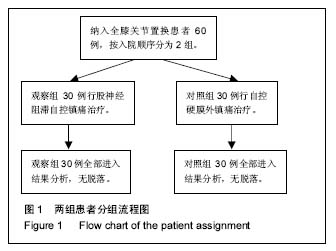| [1] 夏新桂,丁海燕,杨世忠.连续股神经阻滞与静脉自控镇痛泵用于全膝关节置换术后镇痛效果比较[J].中国乡村医药,2016,12(4):13-14.[2] Di Francesco A, Flamini S, Pizzoferrato R, et al. Continuous intraarticular and periarticular levobupivacaine for management of pain relief after total knee arthroplasty: A prospective randomized, double-blind pilot study.J Orthop. 2016;13(3):119-122. [3] Beausang DH, Pozek JJ, Chen AF, et al. A Randomized Controlled Trial Comparing Adductor Canal Catheter and Intraarticular Catheter After Primary Total Knee Arthroplasty. J Arthroplasty.2016;3(16):267-269. [4] 田少渠,田野.规范化镇痛在全膝关节置换术围术期中的应用[J].中国基层医药,2016,13(1):117-121.[5] Ham A, Goyal N, Harris IA, et al. Infection rates with use of intra-articular pain catheters in total knee arthroplasty.ANZ J Surg. 2016;28(2):486-490.[6] 肖美艳.“鸡尾酒”疗法在膝关节置换术后超前镇痛的效果观察[J].中国实用医刊,2015,42(6):94-95.[7] 倪剑武,谷志飞,王权光,等.两种镇痛方法对老年全膝关节置换术后疼痛及应激反应和免疫功能的影响[J].浙江中西医结合杂志, 2015,12(2):142-145.[8] Sculco PK, McLawhorn AS, Desai N, et al. The Effect of Perioperative Corticosteroids in Total Hip Arthroplasty: A Prospective Double-Blind Placebo Controlled Pilot Study. J Arthroplasty. 2015;3(15):1021-1029.[9] 李庆华,邓芳,陶守君.连续股神经置管复合吗啡膝关节注射用于全膝关节置换术术后镇痛[J].浙江创伤外科,2015,12(3): 588-589.[10] 陈虎,付江平.人工全膝关节置换术治疗老年骨性关节炎55例疗效分析[J].新疆医学,2013,43(1):71-72.[11] Brander VA, Stulberg SD, Adams AD, et al. Ranawat Award Paper: Predicting Total Knee Replacement Pain: A Prospective, Observational Study. Clin Orthop Relat Res. 2003;416: 27-36.[12] 徐辉.全膝关节置换在膝关节重建中的应用及技术要求[J].中华损伤与修复杂志(电子版),2013,8(5):458-460.[13] Parvataneni HK, Shah VP, Howard H, et al. Controlling pain after total hip and knee arthroplasty using a multimodal protocol with local periarticular injections: a prospective randomized study. J Arthroplasty. 2007;22(6): 33-38.[14] 刘静,解雪,张其亮,等.疼痛控制对人工全膝关节置换术后患者早期康复效果的影响[J].中华护理杂志, 2010,45(6): 512-514.[15] Lunn TH, Kristensen BB, Andersen LØ, et al. Effect of high-dose preoperative methylprednisolone on pain and recovery after total knee arthroplasty: a randomized, placebo-controlled trial. Br J Anaesth. 2010;106(2): 230-238.[16] 马宁,李露,杨庆国,等.连续股神经阻滞联合浸润麻醉用于全膝关节置换术患者术后镇痛的效果[J].中华麻醉学杂志,2015,15(5): 555-559.[17] 田义华,陈洁,唐永利,等.全膝关节置换术后患者对多模式镇痛的满意度现状研究[J].中国实用护理杂志,2015,31(28): 2123-2127.[18] Sorensen JK, Jager P, Dahl JB, et al. The isolated effect of adductor canal block on quadriceps femoris muscle strength after total knee arthroplasty: a triple-blinded, randomized, placebo-controlled trial with individual patient analysis. Anesthesia Analgesia. 2016;122(2): 553-558.[19] 董江涛,陈百成,康书峰,等.连续硬膜外阻滞用于全膝关节置换术前超前镇痛临床疗效分析[J].中国矫形外科杂志, 2009,17(9): 650-653.[20] Sharma G, Liu D, Malhotra R, et al. Availability of Additional Mediolateral Implant Option During Total Knee Arthroplasty Improves Femoral Component Fit Across Ethnicities: Results of a Multicenter Study. JBJS Open Access. 2017;2(2): e0014.[21] 陈小勇,赵建宁,王与荣,等.全膝关节置换后快速康复外科治疗45例[J].中国组织工程研究,2012,16(17):3065-3068.[22] Emerson RH Jr, Barrington JW, Olugbode O, et al. Femoral Nerve Block Versus Long-Acting Wound Infiltration in Total Knee Arthroplasty. Orthopedics. 2016;17(2):1-7. [23] 张高峰,陈斐,孙立新,等.不同镇痛方式对全膝关节置换术后镇痛效果及炎性反应的影响[J].临床麻醉学杂志, 2015,31(3): 234-237. [24] Burckett-St Laurant D, Peng P, Girón Arango L, et al. The Nerves of the Adductor Canal and the Innervation of the Knee: An Anatomic Study. Reg Anesth Pain Med. 2016;24(12): 99-103.[25] 于国军,杨富林,陆化梅,等.股神经阻滞和收肌管阻滞对全膝关节置换术后镇痛及关节功能的影响[J].广东医学,2017,38(7): 1075-1077,1081.[26] Elkassabany NM, Antosh S, Ahmed M, et al. The Risk of Falls After Total Knee Arthroplasty with the Use of a Femoral Nerve Block Versus an Adductor Canal Block: A Double-Blinded Randomized Controlled Study. Anesth Analg. 2016;3(22): 115-118.[27] 彭周全,张卫,马艳丽,等.术前股神经阻滞用于全麻下全膝关节置换术老年患者超前镇痛的效果[J].中华麻醉学杂志,2015,35(3): 314-316.[28] Klingenstein G, Schoifet S, Reid J, et al. Rapid discharge after total knee arthroplasty is safe in the medicare population. Bone Joint J. 2017;99(Supp 4): 75.[29] 任力,彭丽桦,秦珮珮,等.两种镇痛方式对全膝关节置换术后疼痛及关节功能影响的随机对照研究[J].中华外科杂志,2015,53(7): 522-527.[30] Sawhney M, Mehdian H, Kashin B, et al. Pain After Unilateral Total Knee Arthroplasty: A Prospective Randomized Controlled Trial Examining the Analgesic Effectiveness of a Combined Adductor Canal Peripheral Nerve Block with Periarticular Infiltration Versus Adductor Canal Nerve Block Alone Versus Periarticular Infiltration Alone. Anesth Analg. 2016;2(29):771-775.[31] 倪剑武,谷志飞,王权光,等.两种不同镇痛方法对老年患者全膝关节置换术后镇痛效果和炎症反应的影响[J].中国医师杂志,2015, 17(1):84-86.[32] Mantripragada VR, Piuzzi N, Zachos T, et al. Lateral Femoral Condyle in Varus Knees of Patients Undergoing Total Knee Arthroplasty as a Tissue Source to Identify Early and Mild Histopathological Features of Primary OA. Osteoarthritis Cartilage. 2017;25: S303-S304.[33] 王萍萍,徐丽美,原泉.连续股神经阻滞对全膝关节置换术后康复的影响[J].中国医药导报,2015,2(21):39-42.[34] 张凯,王波,洪汉刚,等.中医药综合疗法在全膝关节置换围手术期镇痛的临床研究[J].世界中医药,2017,12(4):837-842.[35] Hadzic A, Minkowitz HS, Melson TI, et al. Liposome Bupivacaine Femoral Nerve Block for Postsurgical Analgesia after Total Knee Arthroplasty. Anesthesiology. 2016;1(22): 99-105.[36] 夏德国,高巨,纪维,等.超声引导连续股神经阻滞用于全膝关节置换术后镇痛的临床疗效观察[J].医学综述,2015,21(9): 1688-1690.[37] Smith SR, Bido J, Collins JE, et al. Impact of Preoperative Opioid Use on Total Knee Arthroplasty Outcomes. JBJS. 2017;99(10): 803-808.[38] 张玲,崔玉洁,段玉莲,等.个性化疼痛护理对全膝关节置换术患者的影响[J].护理实践与研究,2016,13(14):38-39.[39] Chaubey D, Mahajan HK, Chauhan PR, et al. Comparison of Continuous Femoral Nerve Block versus Local Infiltration Analgesia as a Postoperative Analgesia in Unilateral Total Knee Arthroplasty. J Clin Diagn Res. 2017;11(7):UC13-UC16. [40] Grant AE, Schwenk ES, Torjman MC, et al. Postoperative Analgesia in Patients Undergoing Primary or Revision Knee Arthroplasty with Adductor Canal Block. Anesth Pain Med. 2017;7(3):e46695. [41] Smith EB, Kazarian GS, Maltenfort MG, et al. Periarticular Liposomal Bupivacaine Injection Versus Intra-Articular Bupivacaine Infusion Catheter forAnalgesia After Total Knee Arthroplasty: A Double-Blinded, Randomized Controlled Trial. J Bone Joint Surg Am. 2017;99(16):1337-1344. [42] Mont MA, Beaver WB, Dysart SH, et al. Local Infiltration Analgesia With Liposomal Bupivacaine Improves Pain Scores and Reduces Opioid Use After Total Knee Arthroplasty: Results of a Randomized Controlled Trial. J Arthroplasty. 2017. pii: S0883-5403(17)30640-X. [43] Sogbein OA, Sondekoppam RV, Bryant D, et al. Ultrasound-Guided Motor-Sparing Knee Blocks for Postoperative Analgesia Following Total Knee Arthroplasty: A Randomized Blinded Study. J Bone Joint Surg Am. 2017; 99(15): 1274-1281. |
.jpg) 文题释义:
文题释义:

.jpg)
.jpg) 文题释义:
文题释义: